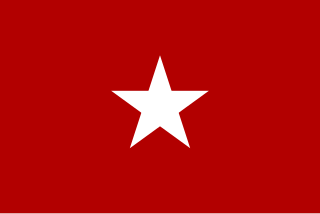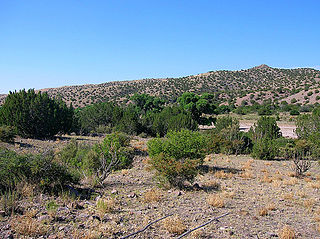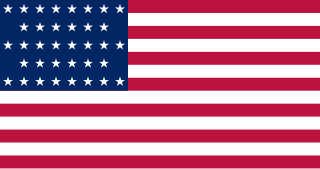Related Research Articles

Arizona Territory, colloquially referred to as Confederate Arizona, was an organized incorporated territory of the Confederate States that existed from August 1, 1861 to May 26, 1865, when the Confederate States Army Trans-Mississippi Department, commanded by General Edmund Kirby Smith, was surrendered at Shreveport, Louisiana. However, after the Battle of Glorieta Pass, the Confederates had to retreat from the territory, and by July 1862, effective Confederate control of the territory had ended. Delegates to the secession convention had voted in March 1861 to secede from the New Mexico Territory and the Union, and seek to join the Confederacy. It consisted of the portion of the New Mexico Territory south of the 34th parallel, including parts of the modern states of New Mexico and Arizona. The capital was Mesilla, along the southern border. The breakaway region overlapped Arizona Territory, established by the Union government in February 1863.

The New Mexico campaign was a military operation of the trans-Mississippi theater of the American Civil War from February to April 1862 in which Confederate Brigadier General Henry Hopkins Sibley invaded the northern New Mexico Territory in an attempt to gain control of the Southwest, including the gold fields of Colorado and the ports of California. Historians regard this campaign as the most ambitious Confederate attempt to establish control of the American West and to open an additional theater in the war. It was an important campaign in the war's Trans-Mississippi Theater, and one of the major events in the history of the New Mexico Territory in the American Civil War.

The Battle of Valverde, also known as the Battle of Valverde Ford, was fought from February 20 to 21, 1862, near the town of Val Verde at a ford of the Rio Grande in Union-held New Mexico Territory, in what is today the state of New Mexico. It is considered a major Confederate success in the New Mexico Campaign of the American Civil War, despite the invading force abandoning the field and, eventually, retreating from the territory entirely. The belligerents were Confederate cavalry from Texas and several companies of Arizona militia versus U.S. Army regulars and Union volunteers from northern New Mexico Territory and the Colorado Territory.

The Army of New Mexico, also known as the Sibley Brigade, was a small Confederate field army in the American Civil War. It operated in Confederate Arizona and New Mexico Territory during the New Mexico Campaign in late 1861 and early 1862, before it was transferred to Louisiana. At first the force was tasked with securing Confederate Arizona's forts, most of which were still in Union hands. John R. Baylor had already established the Confederate Territory of Arizona after the First Battle of Mesilla in 1861. Now the goal was to capture the remaining U.S. held forts in Confederate Arizona and to invade New Mexico Territory. The army also hoped to capture the mines of Colorado and California, to secure gold and silver supplies to finance the Confederate war effort. Ultimately, the Confederate plans were thwarted at the Battle of Glorieta Pass.

The California Column was a force of Union volunteers sent to Arizona and New Mexico during the American Civil War. The command marched over 900 miles (1,400 km) from California through Arizona and New Mexico Territory to the Rio Grande and as far east as El Paso, Texas, between April and August 1862.

The Colorado Territory was formally created in 1861 shortly before the bombardment of Fort Sumter sparked the American Civil War. Although sentiments were somewhat divided in the early days of the war, Colorado was only marginally a pro-Union territory. Colorado was strategically important to both the Union and Confederacy because of the gold and silver mines there as both sides wanted to use the mineral wealth to help finance the war. The New Mexico Campaign was a military operation conducted by Confederate Brigadier General Henry Sibley to gain control of the Southwest, including the gold fields of Colorado, the mineral-rich territory of Nevada and the ports of California. The campaign was intended as a prelude to an invasion of the Colorado Territory and an attempt to cut the supply lines between California and the rest of the Union. However, the Confederates were defeated at the Battle of Glorieta Pass in New Mexico and were forced to retreat back to Texas, effectively ending the New Mexico Campaign.

Fort Craig was a U.S. Army fort located along El Camino Real de Tierra Adentro, near Elephant Butte Lake State Park and the Rio Grande in Socorro County, New Mexico.
Galvanized Yankees was a term from the American Civil War denoting former Confederate prisoners of war who swore allegiance to the United States and joined the Union Army. Approximately 5,600 former Confederate soldiers enlisted in the "United States Volunteers", organized into six regiments of infantry between January 1864 and November 1866. Of those, more than 250 had begun their service as Union soldiers, were captured in battle, then enlisted in prison to join a regiment of the Confederate States Army. They surrendered to Union forces in December 1864 and were held by the United States as deserters, but were saved from prosecution by being enlisted in the 5th and 6th U.S. Volunteers. An additional 800 former Confederates served in volunteer regiments raised by the states, forming ten companies. Four of those companies saw combat in the Western Theater against the Confederate Army, two served on the western frontier, and one became an independent company of U.S. Volunteers, serving in Minnesota.

The area that eventually became the U.S. state of Montana played little direct role in the American Civil War. The closest the Confederate States Army ever came to the area was New Mexico and eastern Kansas, each over a thousand miles away. There was not even an organized territory using "Montana" until the Montana Territory was created on May 26, 1864, three years after the Battle of Fort Sumter. In 1861, the area was divided between the Dakota Territory and the Washington Territory, and in 1863, it was part of the Idaho Territory.

The Battle of Canada Alamosa as it was known to the Union Army, or Alamosa as it was known to the Confederates, was a skirmish of the American Civil War on the late evening of September 24 and the morning of September 25, 1861. It was one of several small battles that occurred in Confederate Arizona near the border with Union held New Mexico Territory, this one being the largest.
The Department of New Mexico was a department of the United States Army during the mid-19th century. It was created as the 9th Department, a geographical department, in 1848 following the successful conclusion of the Mexican–American War, and renamed Department of New Mexico in 1853. It had to contend with an invading Confederate force during the New Mexico Campaign of the American Civil War from mid-1861 to early 1862, then with Apache tribes during the remainder of the conflict. It was merged into the Department of California after the end of the war as the District of New Mexico.
Hispanics in the American Civil War fought on both the Union and Confederate sides of the conflict. Not all the Hispanics who fought in the American Civil War were "Hispanic-Americans", in other words citizens of the United States. Many of them were Spanish subjects or nationals from countries in the Caribbean, Central and South America. Some were born in a US Territory and therefore did not have the right to US Citizenship. It is estimated that approximately 3,500 Hispanics, mostly Mexican-Americans, Puerto Ricans and Cubans living in the United States joined the war: 2,500 for the Confederacy and 1,000 for the Union. This number increased to 10,000 by the end of the war.

Union forces entered Tucson on May 20, 1862, with a force of 2,000 men without firing a shot.

The 1st Regiment New Mexico Cavalry was a volunteer cavalry regiment in the Union Army during the American Civil War.
Robert Murray Morris (1824–1896) was a military officer in the U. S. Army and Union Army. From 1846, he served as a U. S. Army officer in the Mexican–American War and in the antebellum western frontier of the United States in the Regiment of Mounted Rifles, renamed 3rd Cavalry Regiment in August 1861 at the start of the American Civil War. From 1863 he served as a Major in the 6th Cavalry Regiment in the Civil War and afterwards in Texas and Kansas until his retirement in 1873.
The Skirmish near Fort Thorn, New Mexico Territory, also known as the Fight at E Company Grove, was a skirmish of the American Civil War on the morning of September 26, 1861. It followed the Battle of Canada Alamosa one of several small battles that occurred near the border between Confederate Arizona and Union New Mexico Territory. This one being an attempt by detachments of three companies of the Union Regiment of Mounted Rifles to pursue the Confederate cavalry force of Captain Bethel Coopwood's San Elizario Spy Company, and detachments of Company B and E, Second Texas Mounted Rifles, that was retiring from their victory at Canada Alamosa toward their base at Camp Robledo, 12 miles north of Dona Ana, New Mexico.
Independent Companies, New Mexico Volunteer Cavalry were volunteer cavalry companies in the Union Army during the American Civil War.
The 2nd New Mexico Infantry Regiment, officially designated the 2nd Regiment New Mexico Volunteer Infantry or 2nd New Mexico Regiment Infantry, was a volunteer regiment in the Union Army, raised at Santa Fe, in the Territory of New Mexico, during July and August 1861. Its commander was Colonel Miguel E. Pino.

Battery E, 1st Missouri Light Artillery Regiment was an artillery battery unit from Missouri that served in the Union Army during the American Civil War. The 1st Missouri Light Artillery Regiment formed on 1 September 1861. The battery participated in Frémont's expedition to Springfield in October 1861. This was followed by actions at Prairie Grove and Van Buren in December 1862. The following year, the battery fought at Cape Girardeau, Chalk Bluff, Vicksburg, the Expedition to Morganza, Brownsville, and Fort Esperanza. After performing garrison duty at Brownsville, Texas, the unit was mustered out in June 1864. For a few months at the end of 1864, a Pennsylvania battery took the name of this unit.
References
- ↑ Frederick H. Dyer, A Compendium of the War of the Rebellion, The Dyer Publishing Company, Des Moines, Iowa, 1908; (Part 3) Regimental Histories, New Mexico Volunteers, p.1366
- ↑ Jerry D. Thompson, A Civil War History of the New Mexico Volunteers and Militia, University New Mexico Press, Albuquerque, 2015